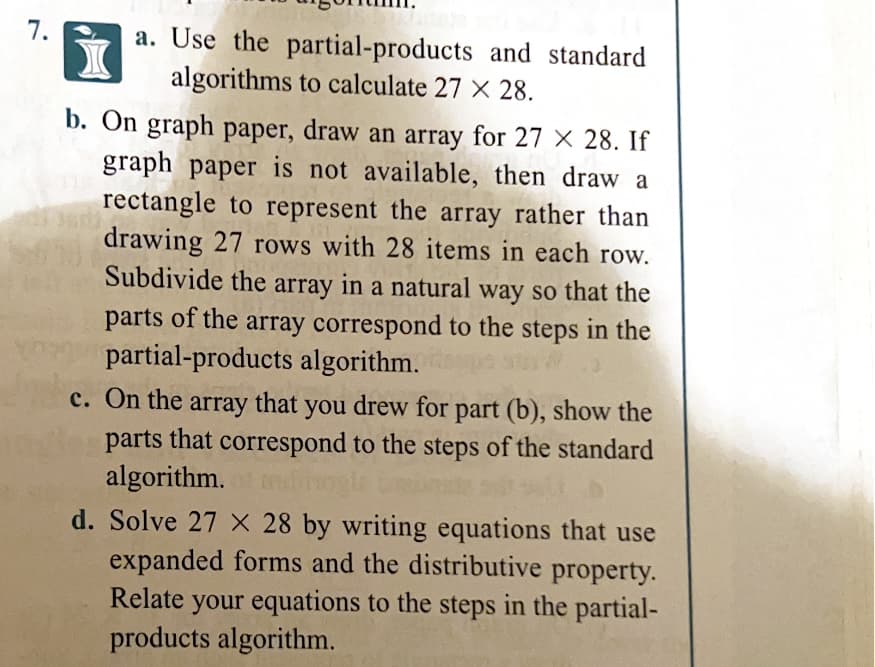a. Use the partial-products and standard algorithms to calculate 27 x 28. b. On graph paper, draw an array for 27 × 28. If graph paper is not available, then draw a rectangle to represent the array rather than drawing 27 rows with 28 items in each row. Subdivide the array in a natural way so that the parts of the array correspond to the steps in the partial-products algorithm. c. On the array that drew for part (b), show the you parts that correspond to the steps of the standard algorithm. d. Solve 27 X 28 by writing equations that use expanded forms and the distributive property. Relate your equations to the steps in the partial- products algorithm.
a. Use the partial-products and standard algorithms to calculate 27 x 28. b. On graph paper, draw an array for 27 × 28. If graph paper is not available, then draw a rectangle to represent the array rather than drawing 27 rows with 28 items in each row. Subdivide the array in a natural way so that the parts of the array correspond to the steps in the partial-products algorithm. c. On the array that drew for part (b), show the you parts that correspond to the steps of the standard algorithm. d. Solve 27 X 28 by writing equations that use expanded forms and the distributive property. Relate your equations to the steps in the partial- products algorithm.
Linear Algebra: A Modern Introduction
4th Edition
ISBN:9781285463247
Author:David Poole
Publisher:David Poole
Chapter2: Systems Of Linear Equations
Section2.2: Direct Methods For Solving Linear Systems
Problem 2CEXP
Related questions
Question

Transcribed Image Text:7.
a. Use the partial-products and standard
algorithms to calculate 27 X 28.
b. On graph paper, draw an array for 27 X 28. If
graph paper is not available, then draw a
rectangle to represent the array rather than
drawing 27 rows with 28 items in each row.
Subdivide the
array
in a natural way so that the
parts of the array correspond to the steps in the
partial-products algorithm.
c. On the array that you drew for part (b), show the
parts that correspond to the steps of the standard
algorithm.
d. Solve 27 X 28 by writing equations that use
expanded forms and the distributive property.
Relate your equations to the steps in the partial-
products algorithm.
Expert Solution
This question has been solved!
Explore an expertly crafted, step-by-step solution for a thorough understanding of key concepts.
This is a popular solution!
Trending now
This is a popular solution!
Step by step
Solved in 2 steps with 1 images

Recommended textbooks for you

Linear Algebra: A Modern Introduction
Algebra
ISBN:
9781285463247
Author:
David Poole
Publisher:
Cengage Learning

Linear Algebra: A Modern Introduction
Algebra
ISBN:
9781285463247
Author:
David Poole
Publisher:
Cengage Learning